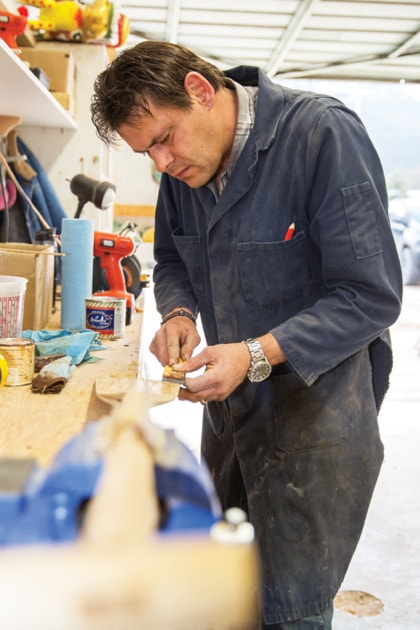Scraping, sanding, grinding, repairing cracks, painting and varnishing have become a routine for the crew restoring the nine original Chinese teak wooden dragon boats.
Now managing the project, the not-for-profit Aspiral Youth Partners Association successfully submitted an application for a grant from the Job Creation Partnership program, which is funded by the Province of B.C. as well as the Government of Canada.
The year-long project officially got underway on Feb. 1, and work will continue until Jan. 27 of next year.
When the 40-foot-long, 1,400-pound teak boats first arrived in Salmon Arm in September last year, Ed Campbell, the project supervisor, started work on one of the boats to determine the best restoration practices tailored for the project.
For the past two months, Campbell has been passing on his expertise in woodworking and restoration to the four participants from the Aspiral Youth Partners, and the first boat is nearing completion.
“They have gone through every inch of that boat,” said Ted Crouch, the project co-ordinator and a Shuswap Association for Rowing and Paddling (SARP) director. “And they will do it eight more times. Each boat will tell its own story.”
Since September, the operation has moved from the Salmon Arm Industrial Park to the former site of Canadian Tire. One of the old Canadian Tire storage buildings was overhauled into the current work space. New lighting was put in, windows were added, and working garage doors were installed to allow for an adequate working environment.
“The lease holder’s improvements in the shop were great, now it’s a great place to get to work,” said Crouch.
While the shop only has room for one boat to be worked on at a time, the other eight are in storage in the old Canadian Tire building itself.
In addition to working on the boat, Kyle Marshall, Christina Pasemko, Les Bennett and Tanner Bradbury-Parlour have also been required to build carts to move the boat, structures to support the boats and a device to roll the boat right-side-up or hull-side-up. The quartet has also earned certificates in first aid, CPR, WHMIS, and will be taking a forklift operations course in April.
“Everything we teach has to really benefit the participants and supply them with valuable work experience,” said Crouch.
He said the goal of the project is to help benefit the community and give the workers the tools to enter the workforce, while preserving a small slice of cultural heritage.
Another local craftsman and restorer, Ric Fletterly, reached out to the project, and restored the drum, wooden dragon head and drummer’s seat.
In April, Fletterly will pass along what he learned working on the detail-intensive pieces to the quartet. The first boat is scheduled to be finished in early April and will be on display at the Mall at Piccadilly for a week starting Monday, April 11.
Putting the boat on display will teach Marshall, Pasemko, Bennett and Bradbury-Parlour event planning and the logistics of presenting the boats to the public.
Crouch is hopeful the team will be able to have an un-restored boat next to the newly restored one to better showcase the progress and work put into the project.
Workers will also be on-hand to answer questions and talk about what they have accomplished, another skill Crouch says is important for them to learn. Work will continue throughout the year, with the hope of getting a couple of the boats in the water by the end of May to early June.
The boat’s formal debut is planned for the coronation ceremony, which will see cancer survivors paddle the boat underneath the wharf during the Dragon Boat Festival.
